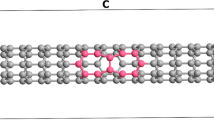Abstract
Electronic properties of multi-defected zigzag single-walled carbon nanotubes are investigated by use of the tight-binding Green’s function method. The Stone-Wales defects and the vacancies are considered. We find that the conductance sensitively depends on the realistic defect configurations for the metallic zigzag carbon nanotubes. Interestingly, the electronic transport properties of the nanotubes with three vacancies can be considered as the sum effect of two double-vacancies, while those with Stone-Wales defects can not. The electron interference along the longitudinal axis and the transport blocking are observed, which may be useful for understanding the electron transport behavior of carbon nanotube in experiments.
Similar content being viewed by others
References
Treacy M M J, Ebbesen T W, Gibson J M. Exceptionally high Young’s modulus observed for individual carbon nanotubes. Nature, 1996, 381: 678–680
Ebbesen T W, Lezec H J, Hiura H, et al. Electrical conductivity of individual carbon nanotubes. Nature, 1996, 382: 54–56
Dunlap B I. Connecting carbon tubules. Phys Rev B, 1992, 46: 1933–1936
Banhart F. Irradiation effects in carbon nanostructures. Rep Prog Phys, 1999, 62: 1181–1221
Choi H J, Ihm J, Louie S G, et al. Defects, quasibound states, and quantum conductance in metallic carbon nanotubes. Phys Rev Lett, 2000, 84: 2917–2920
Suenaga K, Wakabayashi H, Koshino M, et al. Imaging active topological defects in carbon nanotubes. Nature, 2007, 2: 358–360
Alexandre S S, Mazzoni M S C, Chacham H. Edge states and magnetism in carbon nanotubes with line defects. Phys Rev Lett, 2008, 100: 146801
Qian D, Wagner G J, Liu W K, et al. Mechanics of carbon nanotubes. Appl Mech Rev, 2002, 55: 495–533
Srivastava D, Menon M, Cho K. Computational nanotechnology with carbon nanotubes and fullerenes. Comput Sci Eng, 2001, 3: 42–55
Wang C C, Zhou G, Wu J, et al. Effects of vacancy-carboxyl pair functionalization on electronic properties of carbon nanotubes. Appl Phys Lett, 2006, 89: 173130
Wang C C, Zhou G, Liu H T, et al. Chemical functionalization of carbon nanotubes by carboxyl groups on Stone-Wales defects: A density functional theory study. J Phys Chem B, 2006, 110: 10266–10271
Park J Y. Electrically tunable defects in metallic single-walled carbon nanotubes. Appl Phys Lett, 2007, 90: 023112
Kang Y J, Kim Y H, Chang K J. Electrical transport properties of nanoscale devices based on carbon nanotubes. Curr Appl Phys, 2009, 9: S7–S11
Zhou J Z, Wang C Y. First-principles study of the effects of Si doping on geometric and electronic structure of closed carbon nanotube. Chinese Sci Bull, 2005, 50: 1823–1828
Yang B H, Wang Y, Huang Y H. Theoretical studies of C36 encapsulated in zigzag single-wall carbon nanotubes. Chinese Sci Bull, 2006, 51: 25–30
Stone A J, Wales D J. Theoretical studies of icosahedral C60 and some related species. Chem Phys Lett, 1986, 128: 501–503
Monthioux M. Filling single-wall carbon nanotubes. Carbon, 2002, 40: 1809–1823
Zhou T, Wu J, Duan W H, et al. Physical mechanism of transport blocking in metallic zigzag carbon nanotubes. Phys Rev B, 2007, 75: 205410
Gómez-Navarro C, De Pablo P J, Gómez-Herrero J, et al. Tuning the conductance of single-walled carbon nanotubes by ion irradiation in the Anderson localization regime. Nat Mat, 2005, 4: 534–539
Tunvir K, Kim A, Nahm S H. The effect of two neighboring defects on the mechanical properties of carbon nanotubes. Nanotechnology, 2008, 19: 065703
Barinov A, Üstünel H, Fabris S, et al. Defect-controlled transport properties of metallic atoms along carbon nanotube surfaces. Phys Rev Lett, 2007, 99: 046803
Kim S J, Park Y J, Ra E J, et al. Defect-induced loading of Pt nanoparticles on carbon nanotubes. Appl Phys Lett, 2007, 90: 023114
Ouyang M, Huang J L, Cheung C L, et al. Atomically resolved single-walled carbon nanotube intramolecular junctions atomically resolved single-walled carbon nanotube intramolecular junctions. Science, 2001, 291: 97–100
Nardelli M B, Yakobson B I, Bernholc J. Brittle and ductile behavior in carbon nanotubes. Phys Rev Lett, 1998, 81: 4656–4659
Zhou T, Yang L, Wu J, et al. Long-range interaction between Stone-wales defects in zigzag single-Walled carbon nanotubes. Phys Rev B, 2005, 72: 193407
Charlier J C, Lambin P, Ebbesen T W. Electronic properties of carbon nanotubes with polygonized cross sections. Phys Rev B, 1996, 54: R8377–R8380
Datta S. Electronic Transport in Mesoscopic Systems. Cambridge: Cambridge University Press, 1995
Wu J, Gu B L, Chen H, et al. Resonant tunneling in an Aharonov-Bohm ring with a quantum dot. Phys Rev Lett, 1998, 80: 1952–1955
Lindefelt U. Resonances and rotation symmetries in the conductance of armchair carbon nanotubes with extended defect pairs. Phys Rev B, 2005, 72: 153405
Author information
Authors and Affiliations
Corresponding author
Additional information
Recommended by LONG GuiLu
Rights and permissions
About this article
Cite this article
Qian, H., Zhou, T. Electronic properties of multi-defected zigzag carbon nanotubes. Sci. China Phys. Mech. Astron. 53, 11–15 (2010). https://doi.org/10.1007/s11433-010-0107-0
Received:
Accepted:
Published:
Issue Date:
DOI: https://doi.org/10.1007/s11433-010-0107-0




